If you needed one more reason to lay off spraying herbicides in an effort to eliminate all the weeds in your yard, here’s a fantastic one. Dandelions, which are a weed commonly found in lawns all over, are pretty darn good eating. They’re a good source of several vital nutrients, and they’re incredibly easy to find due to their bright yellow flowers. From root to bloom and everything in between, dandelions can serve many purposes. The greens make a tasty, nutritional powerhouse of a salad. The root is often found in herbal remedies and teas. Plus, the flowers are totally edible, as well. You can even make jelly out of them! We’ll go over how you can make dandelion jelly right at home. It’s a great way to make something useful out of something most people don’t want, and it’s a really exciting project to do with kids!
Dandelion jelly has a soft, sweet flavor that is kind of similar to honey, but a little more herbal and with a hint of lemon. It seems like something that would be an amazing sore throat remedy. It goes great on biscuits or cornbread!
Since ancient times dandelion has been highly valued for its extraordinary healing properties in different national cultures. The unique floral confiture is a wholesome delicacy made from dandelion flowers. Early in May flowers are hand gathered on sunny meadows, carefully selected and then gently cooked without using artificial additives and preservatives. The confiture is the most delicate food with fine floral aroma and gentle sweet savor. The cooled jelly is an ideal summer dessert. Its luteous color and refreshing flavor bring you memories of dawning lights during a cold season.
Related: How to Make Dandelion Bread (With Pictures)
Step 1: Harvest Dandelion Flowers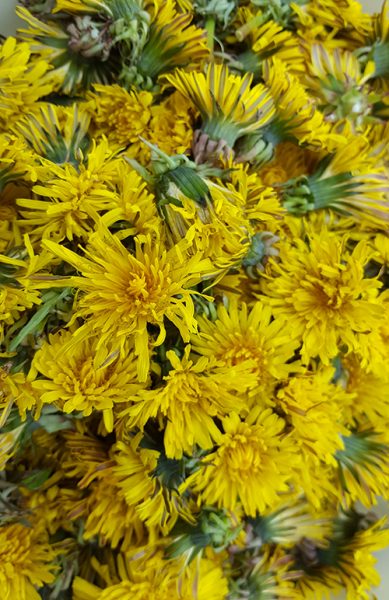
Dandelions can be found pretty easily in spring, summer, and fall, though the golden yellow flowers seem to be found in the highest concentrations in spring. You’ll need a lot of them to make jelly, so be prepared to do a lot of picking! You’ll need one quart (four cups) of dandelion blossoms, but only the white insides and yellow petals. Avoid getting any of the greenery or milky stems into your blossoms. You can trim them for use with scissors, or you can simply use your hands and separate the petals from the base as pictured.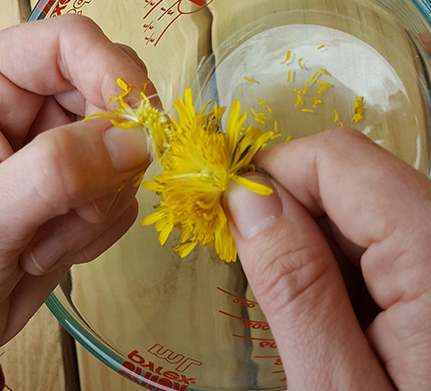 Tips: Avoiding green in your dandelion petals can also help your jelly to obtain a brighter yellow color. The mixture turns a more green-yellow that looks a little sickly if you allow greens into the flower petals! Also, using large, open flowers will help you get the requisite amount faster, and it will help you be able to separate the petals from the greens more easily. Be prepared for stained fingertips, too!
Tips: Avoiding green in your dandelion petals can also help your jelly to obtain a brighter yellow color. The mixture turns a more green-yellow that looks a little sickly if you allow greens into the flower petals! Also, using large, open flowers will help you get the requisite amount faster, and it will help you be able to separate the petals from the greens more easily. Be prepared for stained fingertips, too!
Step 2: Steep the Flowers
There are a couple methods for steeping the flowers, one long and one short. The strength and flavor of your jelly will vary a little depending on which you choose, with a milder flavor for the long method and a more intense, flowery flavor for the short method. You’ll need two quarts (eight cups) of water and the four cups of petals, either way.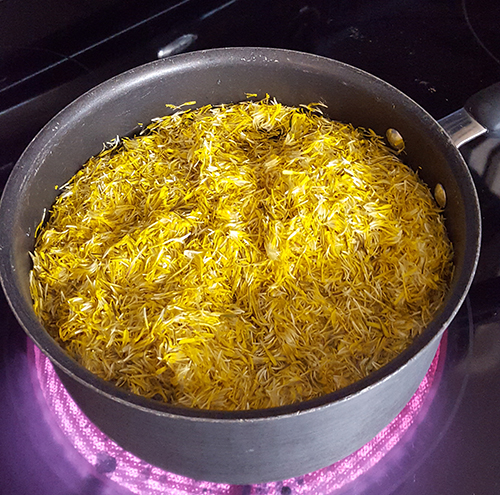
Long method: Pour two quarts of boiling water over four cups of dandelion petals and allow to sit for two to twenty-four hours.
Place the flower petals in a large pot along with 2 quarts of water. Bring the water to a boil and keep it there for ten minutes.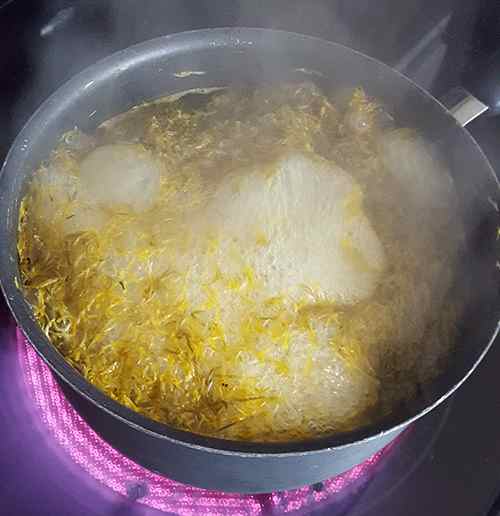
Step 3: Strain
Now, you’ll need to strain the flowers from the water. KEEP THE WATER! That’s what you’ll use to make the jelly. 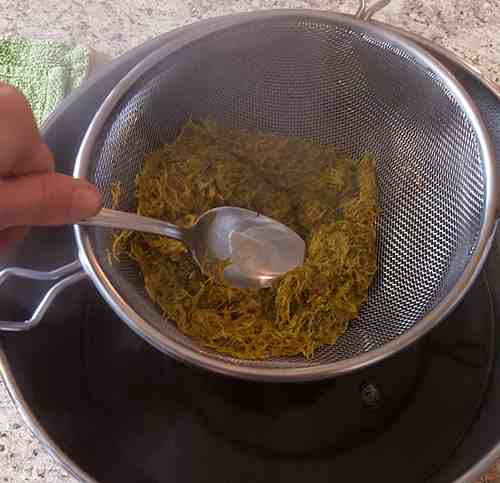 You can do this in a variety of ways including using a fine wire mesh strainer or cheesecloth. Once initially strained, squeeze the water out of the petals. Strain the water again using a coffee filter to make sure you get out all of the solid matter.
You can do this in a variety of ways including using a fine wire mesh strainer or cheesecloth. Once initially strained, squeeze the water out of the petals. Strain the water again using a coffee filter to make sure you get out all of the solid matter.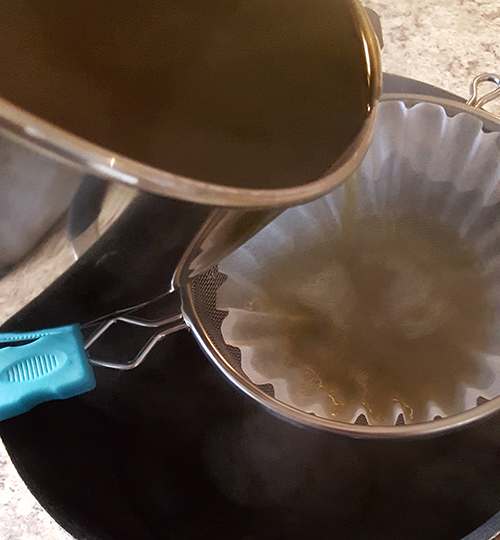
Related: How To Make a Powerful Marigold Extract to Keep in Your Medicine Cabinet (with pictures)
Step 4: Mix Jelly Ingredients Together
Add the following ingredients to a large pot: 2 tablespoons of lemon juice (fresh or reconstituted will do, and lime will work in a pinch, too!), 1 package (1 ¾ ounce) powdered pectin, and 3 cups of the dandelion liquid.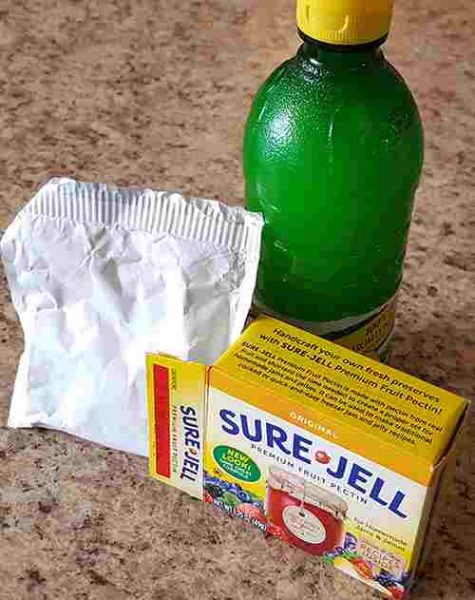
Step 5: Prepare Jars
While many people don’t choose to water bath or pressure can this jelly, instead inverting the jars full of jelly to create the seal, you will still need to prepare the jars regardless of which canning method you choose to use. You can use any size (or shape) canning jar you please. Plan for seven half pints or fourteen quarter pint jelly jars. Place clean jars in the sink and cover with very hot water. You can also use the sterilize feature on your dishwasher to heat jars. It’s not recommended by most jar manufacturers to use dry heat, like in an oven, to heat jars as it may compromise the glass and potentially cause injury.
Related: How to Make Delicious Biltong with 1 Year-Shelf Life
Step 6: Boil, Add Sugar, and Boil Some More
Bring these ingredients to a full boil, then add 5 ½ cups granulated white sugar. Stir well to help the sugar dissolve completely. Boil for an additional 1 ½ minutes, stirring continuously. Check to make sure that the sugar is fully dissolved by dipping in a wooden spoon and watching if the mixture sheets from the utensil.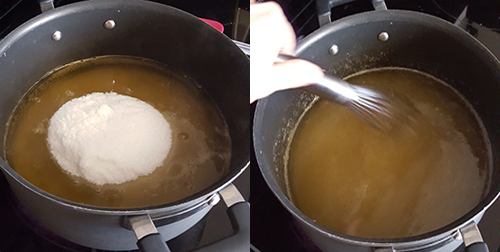
Step 7: Put Jelly in Jars
It’s time to pour your jelly into the hot, clean jars you prepared in Step 5 of this tutorial. Spoon the hot mixture into the jars, leaving 1/8 inch of space at the top. Clean off each jar rim then put the lid and ring in place.
At this point, the jelly can be kept in the refrigerator and used within a couple weeks, or you can seal the jars so that the jelly can keep for up to a year when stored properly.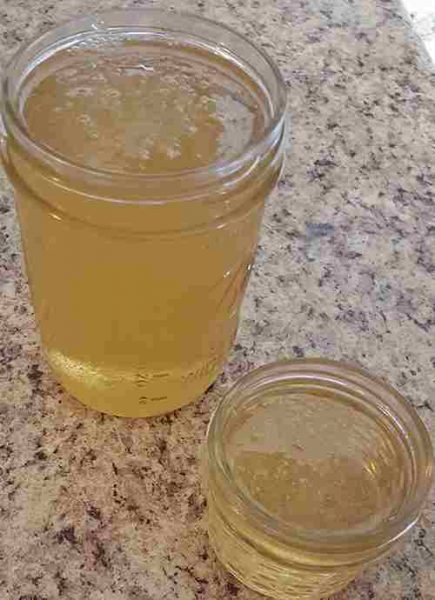
Related: Pioneer Recipes That Survived The California Trail
Step 8: Seal Jars
If you choose to use the inversion method to can this jelly, simply flip the jars upside down on a tea towel that has been laid over a hard surface. Wait about ten minutes and check to see if the jars have sealed by inspecting the button in the center of the lid that pulls in when a proper seal has been achieved. If not, you’ll need to move on to the water bath canning method or use the jelly within a couple weeks’ time.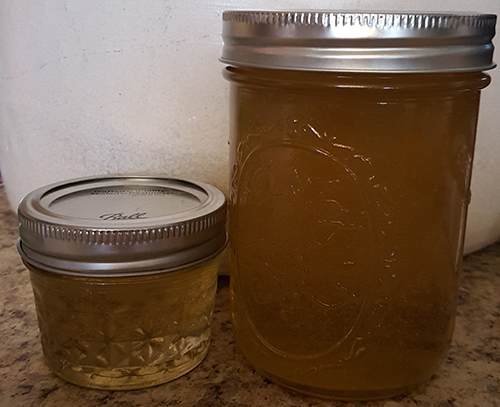
Follow the USDA guidelines for water bath canning of jams and jellies if you choose to use the water bath method. When canned properly, this jelly can be stored for up to two years in a cool, dark area.
Related: 10 Long Shelf-Life Canned Foods Every Prepper Should Consider Stockpiling
It is absolutely recommended that you go ahead and water bath can any jelly you wish to use more than a couple weeks from when you make it. If water bath canning isn’t a part of your plan, please consider giving excess jelly away as gifts so that it can be enjoyed within a couple weeks!
You may also like:
 Similar to Morphine: The Best Natural Painkiller that Grows in Your Backyard
Similar to Morphine: The Best Natural Painkiller that Grows in Your Backyard
If You Are to Weak to Prep then You Need to Watch This (watch video)















This would be worth trying
Hi, love it, now I need to find dandelions! i live in the desert, but some are in parks. I hope they are not treated with pesticides already?
Probably already sprayed, but you can always collect some of the plentiful seeds & plant your own special garden for next season 🙂
MY SYSTEM WILL NOT PRINT FROM “PRINT THIS ARTICLE”.. HOW DO I PRINT WITHOUT ALL THE ADVERTISEMENTS?
Highlight the article, then copy and paste onto a Word, Word Pad, or whatever word processing program you have, then you can edit out the ads as your please and print and save from that w.p. program.
Create a document from software that you have. Copy and paste the text. Save. Print.
That’s a lot of sugar. I’m not familiar with making jelly. Do most recipes call for this much?
Yep what do you think jelly is? It is basically a whole bunch of sugar water flavor with a berry or leaf or flower add the pectin to gel it up…
Sounds like fun! I live in the country, avoid sprays & currently “harvest” my plentiful dandelions for neighbor’s ducks – they LOVE ’em. Guess they’ll have to share 🙂
good for you i know sombody who does the same as for me i make wine …thisle flowers make good lavender colored jelly and yummy to not the bull thistle
Looks like yummy 🙂 I will try
Did I miss something? What is the short method of steeping the flowers? Thank you.
Yup – they neglected to preface the directions with “Short Method”:
Short Method: Place the flower petals in a large pot along with 2 quarts of water. Bring the water to a boil and keep it there for ten minutes.
Thank you for the clarification!
Grasp the green bud between the index finger and thumb, and roll it a couple times and the yellow innerds will pop right out…
Obviously you’ve never seen anyone make jelly. There is a lot of sugar in all jellies. Homemade jellies tend to be richer in flavor than commercially made ones so it takes less. Besides a little jelly on a biscuit isn’t going to rot out your teeth. And in an SHTF event, some real, homemade jelly will be a great moral booster.
I can remember when I was a child my grandma used to walk around the back yard and pick dandilions , mustard greens, turnip greens,and there was another one that I can’t remember the name of. They made a great salad. And I also remember the dandilion jelly. She also made homemade mayo and lye soap in a huge castiron pot over a open fire with lavender in the soap.
The Dandelion Flower as well makes a great Wine.
My Polish grandmother made dandelion wine – very sweet – I preferred it 1:4 with soda water.